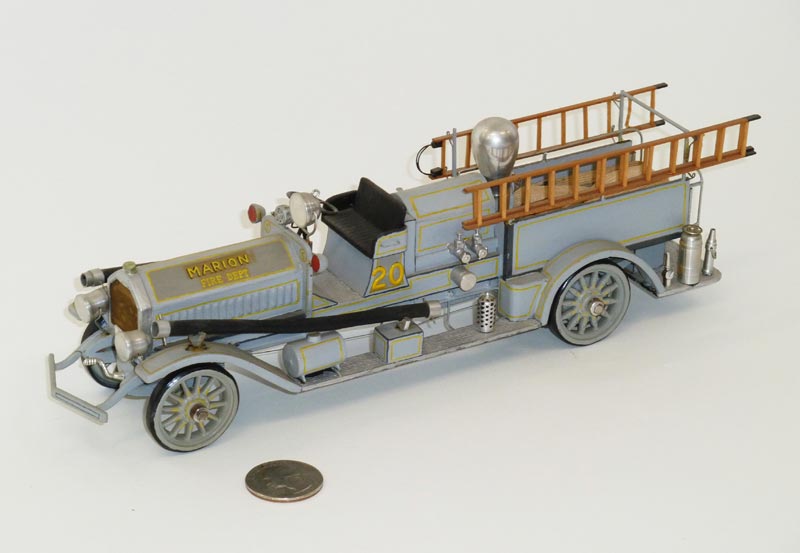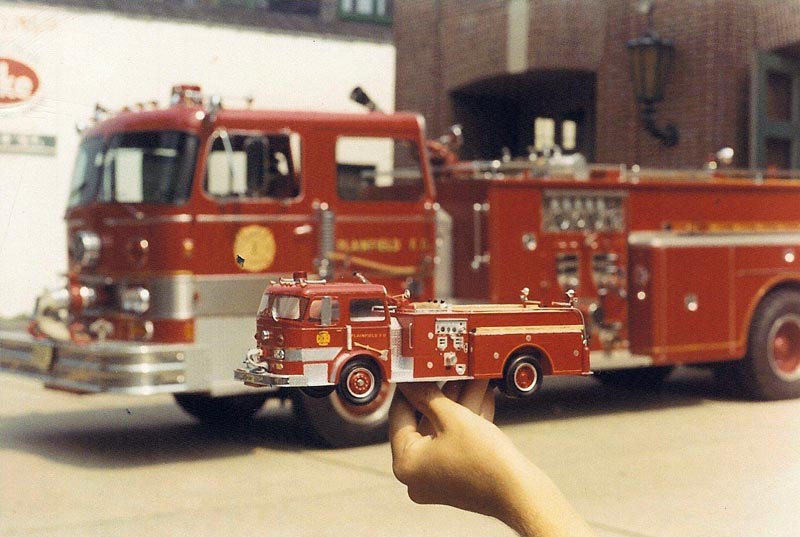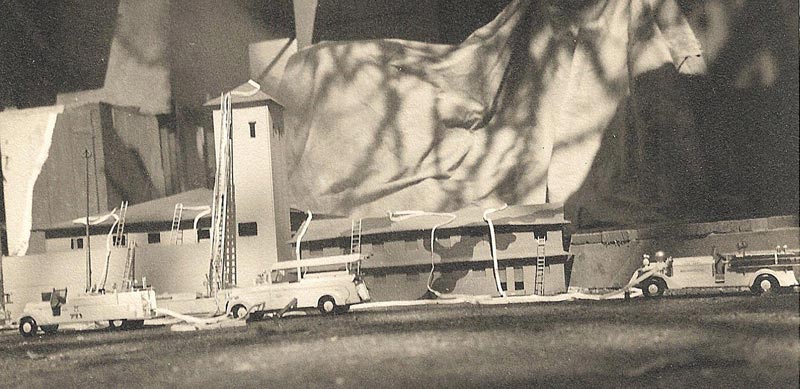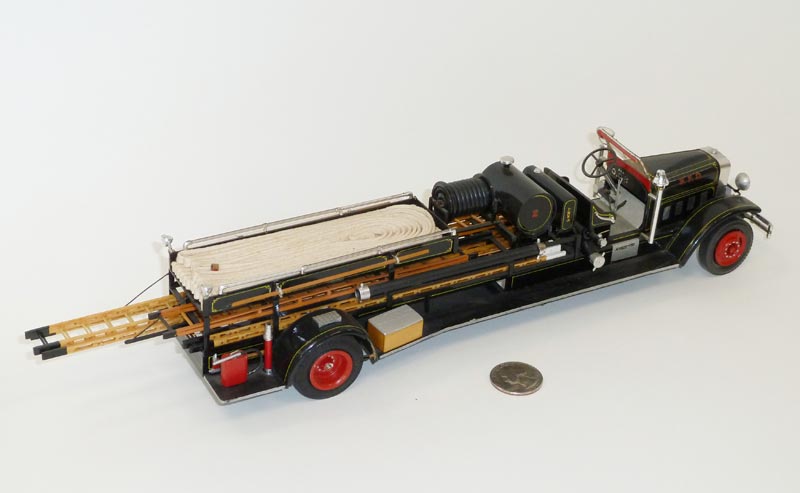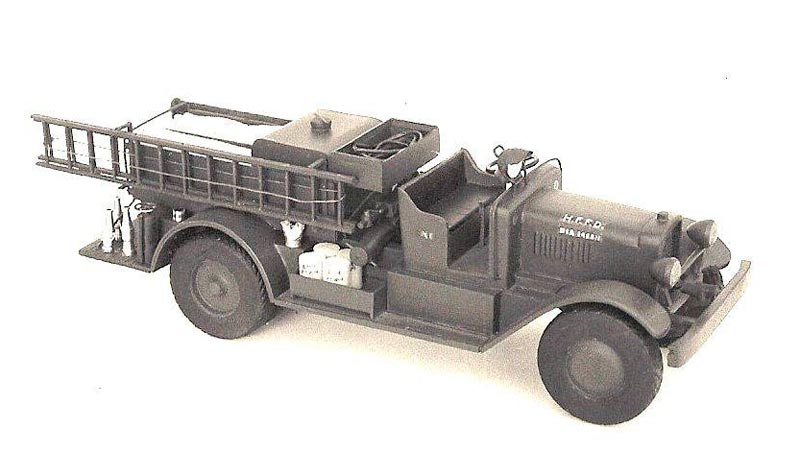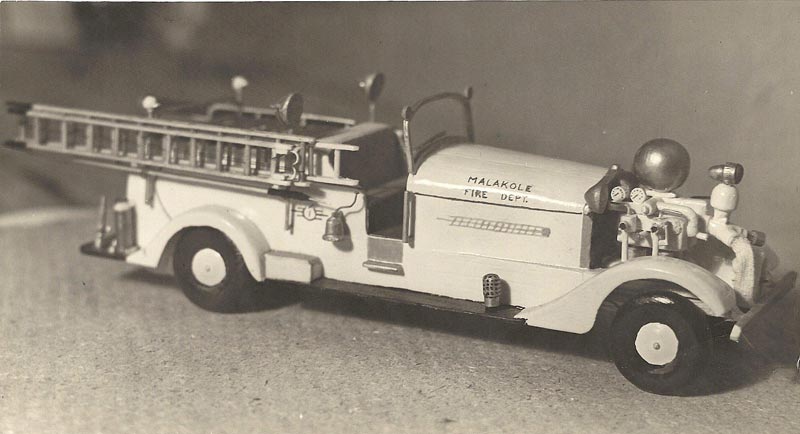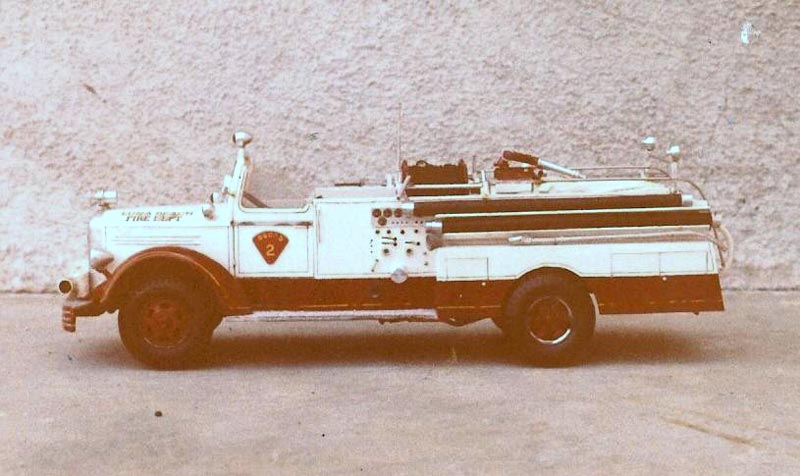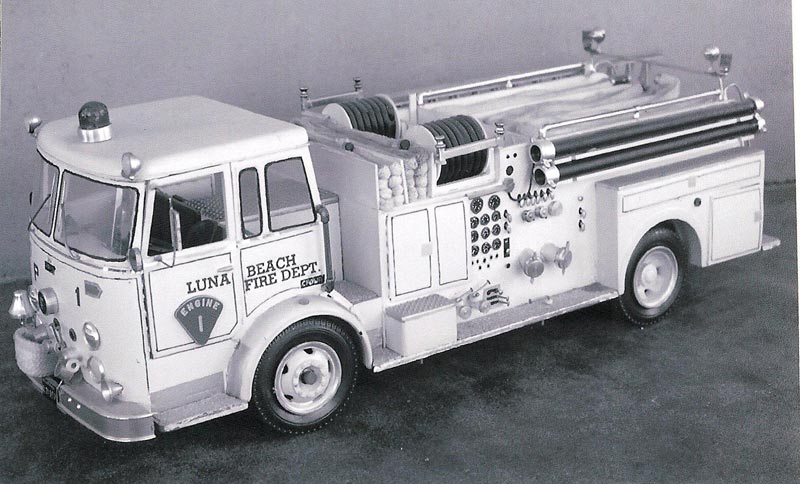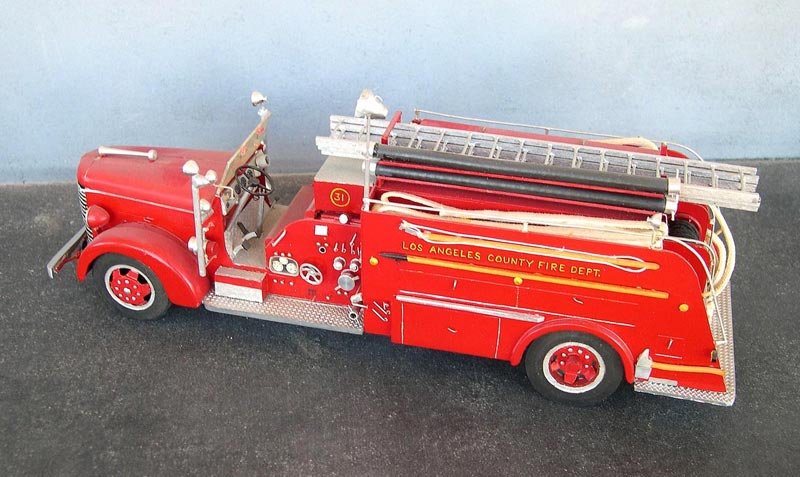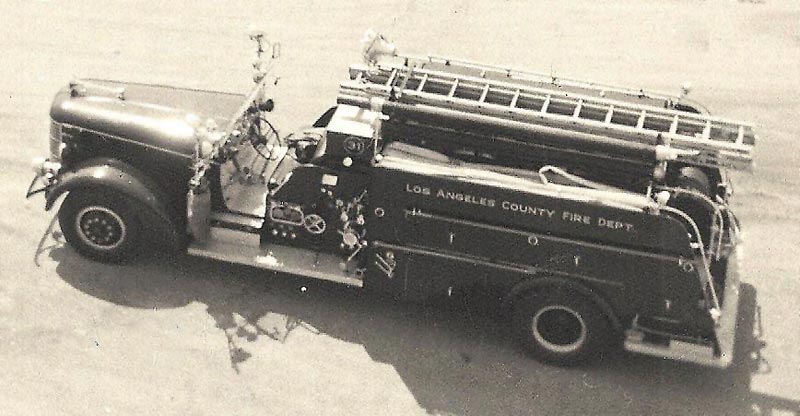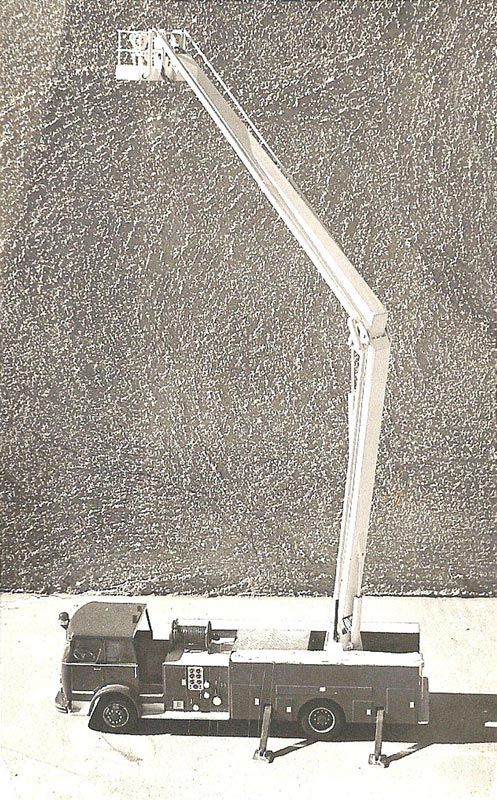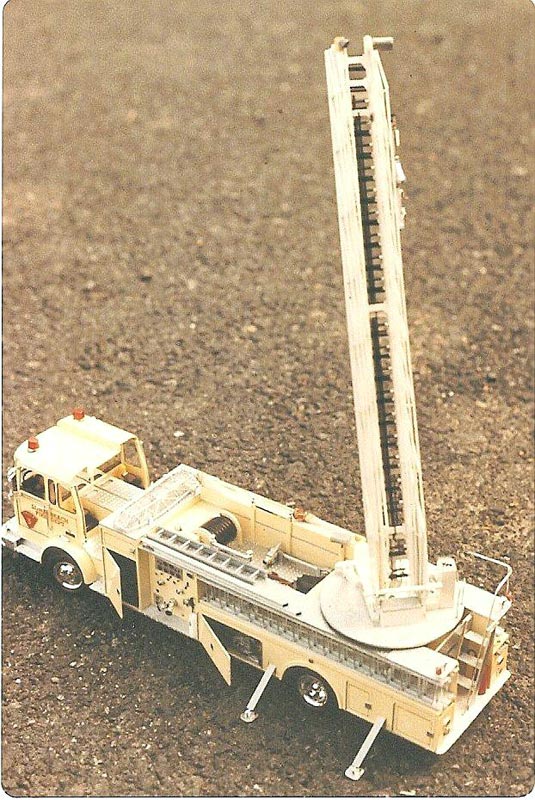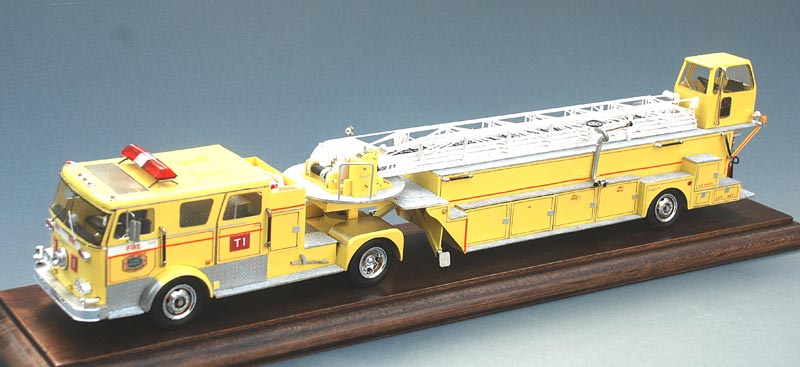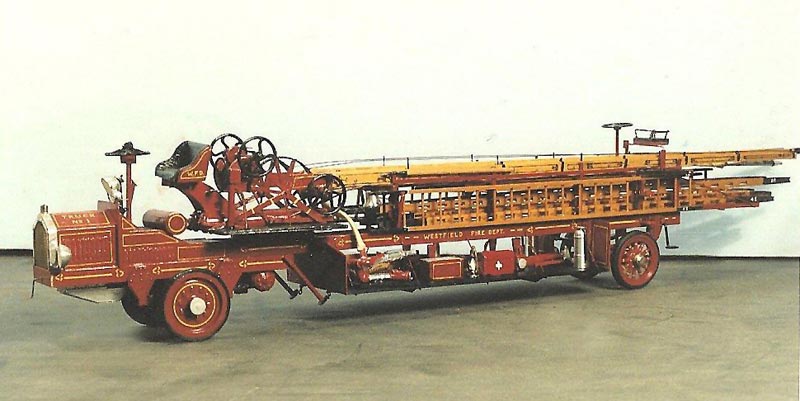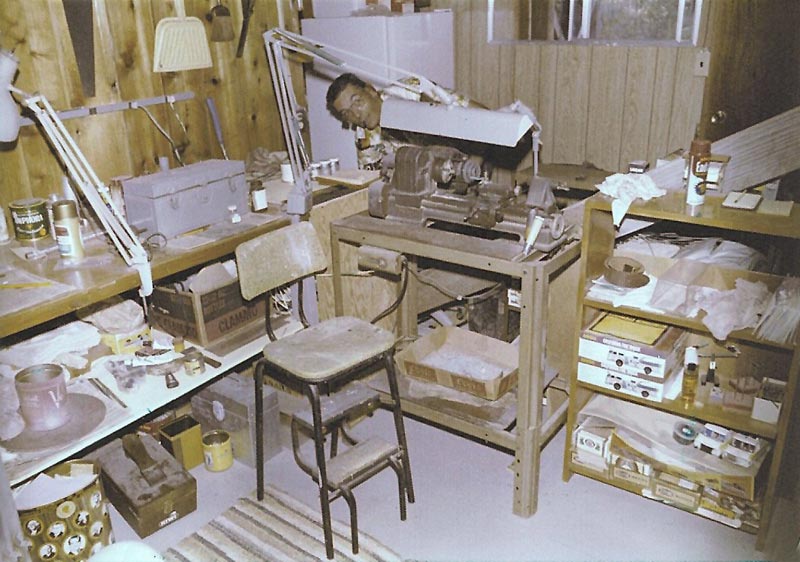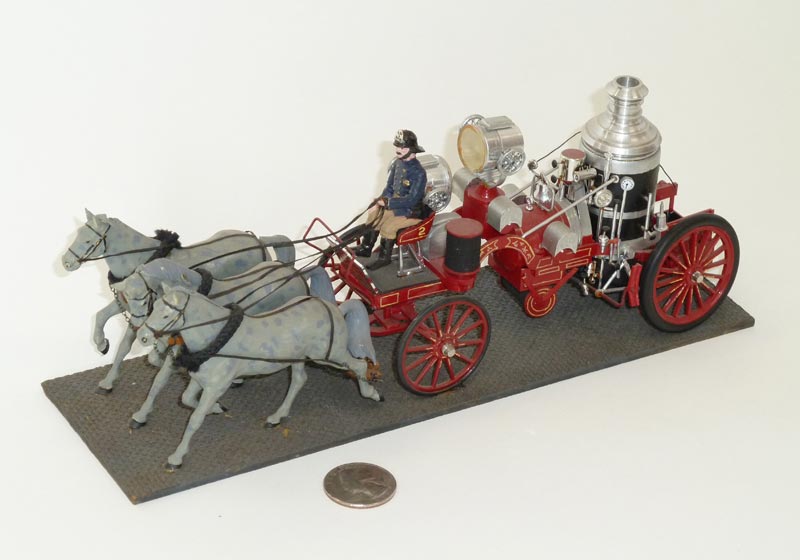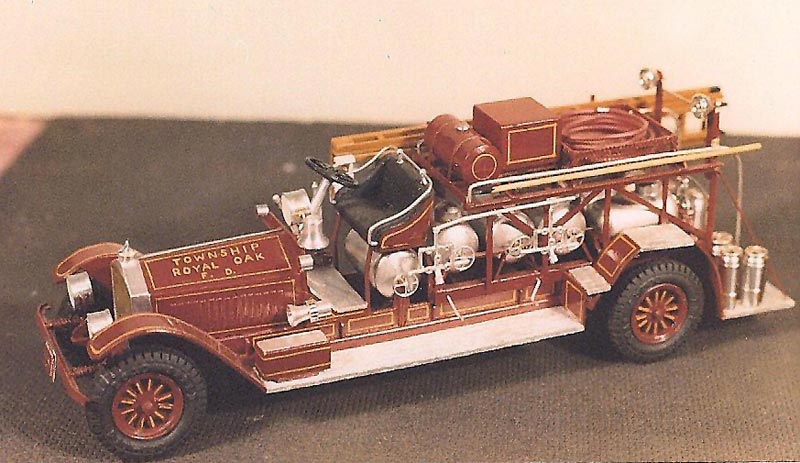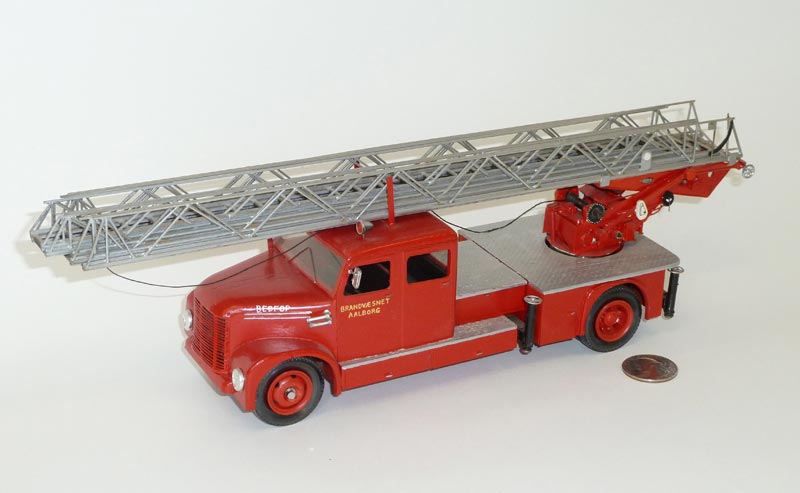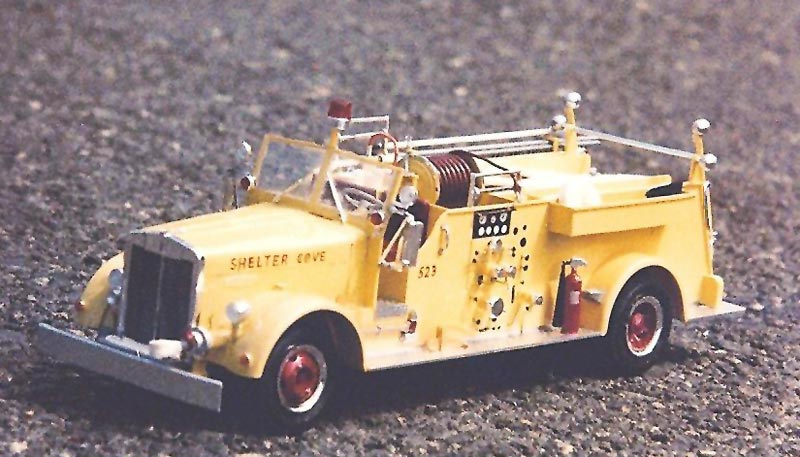1917—1996
Building a Collection of Firefighting Apparatus That Span Decades
Introduction
One of our featured craftsmen, John Ackerman, first visited the Miniature Engineering Craftsmanship Museum in 2011, and brought along some beautiful model fire apparatus he had built. John recalled that a noted fire apparatus model maker, Tom Showers, had inspired him to get serious about his own model making. Tom began building models in the early 1940s, and carried on with the hobby throughout his life. All told, Tom created over 400 models of firefighting apparatus. He also inspired and mentored fire apparatus model makers around the world.
Now, Tom also did commission work for enthusiasts worldwide. Periodically, he would sell models from his collection, or in some cases he traded them for parts. In this way, John was able to collect a number of Tom’s earlier work. While the majority of Tom’s models now reside in firefighting museums in the Los Angeles area, or in private collections around the country, John wanted Tom’s work to be available to a wider audience.
Ultimately, John brought several of Tom’s models for display at the Miniature Engineering Craftsmanship Museum. Now Tom’s work can be thoroughly appreciated, and the skill of a lifelong builder is preserved for future inspiration. Even those who don’t know where the ladders go on a 1915 Robinson will appreciate the fine details in each of Tom’s models. John has put together a nice retrospective on Tom’s work, including the building of a complete fire department for his mythical city of Luna Beach.
Tom built this 1/32 scale model Robinson engine in 1951. The engine was donated by John Ackerman, and is one of Tom’s earliest models built from basswood. In fact, the number 20 on the door indicates that it was Tom’s 20th model. It represents an engine from the Marion (OH) Fire Department, circa 1915.
Tom Showers: Fire Apparatus Model Maker Extraordinaire
By John A. Ackerman
The War Years
Newly transferred to Camp Malakole, Hawaii, in early 1941, Corporal Tom Showers was assigned to a searchlight battery that utilized mobile light trucks. Many of his fellow soldiers were building model airplanes to help pass the time. Tom elected to make a model, from balsa wood, of a searchlight truck. It turned out pretty well, and happened to resemble a fire department rescue/searchlight truck.
Since Tom had an interest in (and knowledge of) firefighting before joining the US Army, he painted the truck red and called it, Rescue 1. Then, working from memory he made a Seagrave pumper to go with his rescue truck. Tom compared the model to the apparatus at one of the Honolulu fire stations, and found it surprisingly accurate. Like the rescue truck, this model was made from balsa wood, with various odds and ends scrounged from a local hobby shop.
Tom also discovered that both trucks were very close to 1:32 scale. This would become his lifetime scale of choice. Adding an architect’s scale ruler to a small collection of tools, he began planning and making additional model fire apparatus.
During this time, a military fire department was formed at Camp Malakole. Tom was the only one who knew anything about firefighting and fire apparatus operation, so he passed the chief’s test with flying colors. He became the fire chief, advancing from corporal to line sergeant to acting staff sergeant. Using his models, along with painted cardboard to represent buildings, and string for hose lines, Tom conducted tabletop training exercises for his crew.
Reality struck on December 7, 1941, with the attack on Pearl Harbor. Tom and his crew fought fires on the naval base for over 76 hours straight. After the attack, Tom discovered a .50 caliber bullet had left one of his newly completed Mack pumpers in shreds. He kept the damaged model for years. However, in time he threw it away because it reminded him of those terrible hours during the attack, and the subsequent firefighting and rescue efforts. Tom didn’t talk about those experiences very often.
All these early models were of late 1930s through 1942 vintage: the rescue truck, Seagrave pumper, an American LaFrance pumper, and a Mack pumper. He also constructed a cardboard fire station.
Eventually, two American LaFrance ladder trucks were added: a tractor-drawn 100’ aerial, and a JOX type mid-ships 65’ aerial. The rungs of the aerials and the assortment of ground ladders were made of thin balsa wood strips.
Tom was transferred to the U.S .Army Air Corps and stationed at Hickam Field (HI) Fire Department. There he served as an engine captain, captain of fire prevention, and drill master. During Fire Prevention Week in 1942, he was invited to set up a model display at the local McInery’s shoe store. The store’s window dresser crafted a scale block of storefronts and added fake fire.
Another one of Tom’s miniature engines that was donated by John Ackerman. This is a 1/32 scale 1932 Seagrave rescue car. This rig is equipped with an overhead ladder rack, four searchlights, and a compartmentalized body. It was designed to carry various rescue tools and equipment for the Sacramento FD.
Tom’s 1/32 scale Ahrens-Fox model is courtesy of John Ackerman. It’s a standard line quad in an unusual black color. Many volunteer fire departments in the eastern part of the country continue to paint their apparatus in colors other than red. Tom replicated many such rigs in a variety of colors schemes.
Then, hoselines were laid and ladders were raised to simulate firefighting operations. The display enjoyed a popular month-long run, and afterward Tom was invited to set up the same display at the Honolulu Public Library.
Tom was inspired to make another fire station. He collected some 7,000 used matchsticks for material. He glued them in rows like bricks, then coated them with six layers of varnish. Unfortunately, due to its size he couldn’t take the station with him when he transferred out. Since no one was interested in taking it, he set it on fire.
After shattering his knee at a large fire, Tom was transferred to the McCook Army Air Base Fire Department in Nebraska. There he served as an assistant chief, a position he held until the end of the war.
Three days before his discharge, Tom was hired by the Los Angeles County Fire Department on an “as-needed” basis. He took the first peace-time exam shortly after, and officially joined the Los Angeles County Fire Department in September 1945.
This unique balsa wood model is a replica of the engine on which Tom served as Captain. The ladder is balsa strip stock with bamboo rungs. The nozzles at the rear were added once Tom was stateside, and had acquired a lathe.
From Malakole, to Long Beach, to Luna Beach FD
During the war years, Tom lettered his training rigs “Malakole FD.” When he went to Hickam Field, he began lettering them “Long Beach FD,” after his hometown in CA. Now that he was a firefighter with the Los Angeles County FD, he decided his budding fire department needed another name. Doing some research he found a Luna Beach, NY. All he had to do was change two letters, thus the Luna Beach Fire Department was born.
Tom’s scale model 1950 Mack “Squad” truck. The first rigs for the Luna Beach FD were painted white. Around 1949, Tom started to paint them white over red, but eventually switched to yellow some years later. Basswood and Renwal wrecker kit wheels replaced the original pine and Bristol board wheels. Tom used turned aluminum for pats and black string for reel line.
Making Luna Beach
The mythical city of Luna Beach is a composite city of 15 square miles. Its location approximates the California city of Long Beach, with commercial and business districts, residential areas, heavy industrial areas, a harbor, petrochemical facilities, and an airport. Originally, the city’s population was estimated to be 50,000; however, by 1965 it had grown to over 125,000.
Tom’s highly detailed hand-drawn map (600’=1” scale) shows streets, parks, schools, hospitals, and large commercial and industrial facilities. Fire hydrant locations and fire alarm boxes are shown, as well. A set of more than 600 “running cards” indicate what resources would respond to a specific fire alarm box location.
A display of two of Tom’s scale American LaFrance aerial ladder trucks in 1942. The apparatus are made entirely from balsa wood.
Luna Beach Fire Department
The Luna Beach Fire Department was the cornerstone of Tom’s modeling achievements. It has been a showcase for many different types of apparatus,including: tractor-trailer aerials, mid-ship mounted aerials, rear-mounted aerials, articulated platforms known as Snorkels, standard pumpers, large-capacity pumpers, hose wagons, heavy rescues, squads, utility and support rigs, industrial rigs, and airport crash trucks. Tom’s scale model fire apparatus were made with the highest degree of craftsmanship and detail.
Models were based on real apparatus, and have steerable wheels and compartments that open to display miniature handcrafted tools and equipment. Often, Tom would incorporate ideas collected over years of experience as both a firefighter, and from visiting fire departments around the country and overseas.
Quartered in five fire stations are: nine engines, three ladder trucks, a heavy rescue, a hose tender, two foam trucks, two support trucks, three ambulances, a light and generator trailer, three chief’s cars, three airport crash trucks, three fireboats, two reserve engines, and a drill tower with petrochemical training props. Tom’s fire stations have detailed interiors, including working lights. He periodically upgraded his stations, either by rebuilding or making a new one.
Tom updated his Luna Beach rigs just like an actual fire department. Models slated for replacement were either rebuilt, repainted, re-lettered, and added to his main model apparatus collection—or they were sold to collectors. Every so often, Tom would trade a retired model for parts made by other fire apparatus model makers. Sadly, he would trash older models if he felt they weren’t quite up to standard.
This Luna Beach FD fire boat was based on the 1964 Los Angeles FD fire boat No. 4. Tom made a wide variety of different fire apparatus for his fictional city.
Tom’s R&D Works
Now, Tom’s first model was based on inspiration, and the next was built from memory. From there, he started collecting information, plans and photos. More often than not, he would measure the actual piece of apparatus. When enough information was gathered, Tom would make highly detailed drawings in his primary scale of 1:32 or 3/8” = 1’. He generally had no less than four architect’s scales in his work areas.
Throughout all his travels—stateside and overseas—Tom carried a notepad, tape measure and camera. Eventually, he amassed quite a collection of original factory blueprints, factory photographs, his own detailed photographs, and pages of specific measurements. From those notes, he would draw his own set of plans. Tom also collected an in-depth library of fire apparatus books featuring both American and foreign apparatus. He generously made copies of both his photos and detailed blueprints available to other fire apparatus model makers.
Tom’s collection of foreign fire apparatus plans, information and photos was also quite extensive thanks to both correspondence with fire model makers abroad, as well as trips he took with his wife.
Tom’s early models were made from balsa wood. He would apply enough filler to firm up the surface, for both durability and to achieve a smooth finish for painting. Tom also carved the small parts and accessories from balsa wood, which was difficult at best. He incorporated thin pine stock when available, and eventually began using shape and strip stock basswood. This material was much firmer than balsa wood, and easier to work with. He would shape either balsa or pine wood, and lay on fiberglass for front ends and roofs. Tom still preferred to build fenders with up to five carefully cut pieces of basswood sheet stock.
A scale model 1940 Los Angeles County FD American LaFrance tanker, Engine Co. 31. This was Tom’s first engine when he transferred to Fire Station 31, built in 1955. It’s made from basswood with machined aluminum parts and accessories.
When Tom got his lathe in the early 1950’s, it opened up a whole new world. Now he could make all his own nozzles, sirens, headlights, spotlights, and searchlights. Fire extinguishers and a host of other small parts and accessories were also now possible by machining aluminum round stock.
Tom used a tiny hand drill to make mounting holes in newly turned aluminum parts. He became very good at it—doing so right up until his last years. On his “inside” work desk, Tom used a Dremel tool for carving wood shapes.
With the Dremel drill press, he could drill holes in two beams of basswood at a time for his tiny wooden ladders. When Tom shifted over to using sheet styrene plastic, he discovered that cutting along a steel straight-edge with a razor blade would make a sharp cut with little to no furrow, which could be easily snapped off. Tom would use two different hot knives, one with a small soldering tip, and another with an X-acto cutting blade.
This 1962 Yankee Walter crash truck was made for Tom’s Luna Beach FD. It was crafted from basswood, but the nozzles and lights were turned from aluminum round stock. Tires were cut from pine with Bristol board and pinheads for lug nuts. This model and photo are from the collection of Bob Milnes.
The hot knife with the soldering tip enabled Tom to literally weld joints in the plastic. The other hot knife was used for both cutting out plastic and to make diamond tread plate. On a piece of plastic he would lay out a grid of 1/8” squares. The first set of scoring marks were done at the nexus of the squares, and then perpendicular to those marks. In the squares he made a second set of score marks. The plastic would raise slightly, and when silver paint was applied, would resemble the correct size diamond plate.
Ambroid glue and carpenters wood glue served well in the days of wooden models. However, plastic required the use of MEK, which was very thin, would quickly fill spaces to be glued, and then melt in slightly. It also had the advantage of being very fast drying. When Tom combined the styrene with ABS plastic parts purchased from then EMA (Engineering Model Associates, now known as Plastruct), he would use their specially made multi-plastic glue.
Pin-striping was accomplished with a drafting ink pen and compass. Tom slightly thinned bright yellow enamel, and added a drop or two of red to make a rich color, then carefully went to work. He used a tiny brush for some of the minute artwork.
The lettering was all done by hand, directly on the model. Sometimes he would use press-on letters or hand lettering on blank decal paper, which would be applied to the model.
Tom’s files also included sales brochures, photographs, and measurements of all kinds of firefighting tools and equipment. He would carefully make whatever tools and equipment were required for the particular model he was working on.
In 1959, Tom modeled his first 65’ snorkel on a Crown Firecoach body. The body was made from sheet and strip stock basswood. Tires were cut from pine with Bristol board wheels and pinheads for lug nuts. The snorkel boom was also made from basswood. Tubing and fittings are from Plastruct. Pump inlets/outlets are turned aluminum. The beacon light has a turned aluminum base, with a lens made from a red pill capsule cut to size.
In 1967, Tom started painting the Luna Beach models a lemon yellow color. This 1972 Crown 100’ aerial ladder truck was made from sheet styrene plastic. Some parts were from the Aurora pumper kit, including the wheels and tires. The aerial ladder was made with basswood 1/32 square strip stock, basswood channel for the beams, and spaghetti for the rungs. Cabling was button thread and strung to enable the fly ladders to extend sequentially. The diamond plate is made by scoring the sheet plastic with a hot knife.
Making Wheels and Tires
Tom’s first model wheels were carved from balsa wood. In late 1952, a friend made a clever cutting tool to cut tires from a block of pine. Tire treads could be scored in by mounting the wood tire on a drill motor or in a lathe. Round and shaped pieces of Bristol board with pinheads for lug nuts, when painted, made very credible Budd wheels. During the late 1950’s, the Renwal company introduced a 1:32 scale plastic kit of a military wrecker. Tom was ecstatic. He bought many of these kits for frames, running gear and their nice wheels. Even the military figures could be reconfigured into scale firefighters.
Another word about Tom’s adherence to 1:32 scale: He reasoned that anything larger would be difficult to showcase. However, he was happy to do commission work in either 1:32 or 1:24 scale.
In 1964, the Aurora company produced an American LaFrance 900 Series pumper kit in 1:32 scale. Tom purchased these kits by the case. He used the wheels, frames, running gear and various small parts. In 1967, he began working in plastic—specifically, the high-impact styrene available commercially in large 30 x 60-inch sheets (in a variety of thicknesses).
He also made use of the plastic tubing and parts made by Engineering Model Associates, Inc., a company that manufactured items for scale model making of various industrial/petrochemical facilities. A division of this company later formed that is today known as Plastruct, which continues to provide a large variety of plastic materials and components for model makers worldwide.
Tom’s 1973 Seagrave 100′ tractor-trailer aerial truck for the Luna Beach FD. It’s made from sheet styrene plastic with turned aluminum parts. The truck also has various parts from an Aurora kit, including wheels and a side mounted wagon battery using tubular fitting from Plastruct. Ladders are basswood beams with spaghetti rungs. The aerial ladder is made from styrene strip stock.
A 1928 American LaFrance aerial ladder truck made of basswood channel, strip, and sheet stock. Parts and accessories are turned aluminum. The truck is equipped with modified kit wheels. Ladders are basswood strip stock with bamboo rungs. The aerial raises, rotates and fly ladder extends. It was made in 1966.
Now, Tom fashioned spoke or artillery wheels—both solid-rubber and pneumatic—by using the hub and spokes from a kit. (In the ‘50s, wood kits would often contain plastic spoke wheels). However, they would have to be cut down to the proper scale size and fit into either a turned-wood or aluminum rim. Sometimes Tom would turn the rim and hub from aluminum, and remove enough material in between so it could be easily carved out. He would then very carefully drill or carve out the excess, leaving four spokes in place.
The correct number of 1/16” square basswood pieces were added, then painted and pin-striped. Solid rubber tires were added by wrapping actual rubber around the wheel. Eventually, he would use either plastic tubing for tires, or a piece of styrene plastic cut the width of the wheel, and long enough to be bent in a curve around the wheel.
The assembled tire would then be glued in place and painted. Solid wheels were scrounged from military tank kits and customized for the particular fire model.
As 1:32 scale “Snap” kits increased in hobby shops, Tom began to use the wheels and tires, as well as running gear, frames, and other odds and ends. Instead of buying tools to make tasks easier, Tom would check out available plastic at hobby shops.
Tom was gifted in that he could visualize a kit, and correlate the parts to a planned model fire rig. The only real downside was that his models were incredibly fragile. He used glue very sparingly, and was not one to add a lot of structural reinforcement.
Tom painted this Mack pumper baby blue, representative of one of the Chambersburg Fire Companies. The body and carved fenders were made from basswood. Some parts and accessories are from an Aurora kit. The searchlight, front spotlights, and headlights are turned aluminum.
Tom’s Work Spaces
While Tom and his wife were raising their two daughters, he built his miniatures in a garage workshop. Eventually, he was able to move into a spare bedroom.
There, Tom set up his work desk, a cabinet or two, a model display case, and a display rack for his fire stations. His lathe, airbrush equipment and supply storage remained in the garage.
After he retired and moved to another home, Tom kept his lathe, painting tools and supplies in a separate shed. This shed was also excellent for model work that overflowed from his study. Another component of Tom’s work spaces was bagpipe music. For some time, he was a Drum Major for a Southern California Pipe Band. He was never without a quality record player!
Beyond the Luna Beach Fire Department
All in all, Tom’s modeling efforts covered all types of fire apparatus, both American and from around the world. Part of his collection included models of very early hand-drawn and horse-drawn apparatus, as well as an array of early motorized rigs. There were many unusual rigs. A significant portion of his collection are models depicting a wide range of colors other than red, which is used by American fire departments. Tom devoted a lot of energy to making models of foreign fire apparatus. To see the entire collection and compare years, types and nation of origin was impressive.
Tom Showers’ accomplishments in the world of replica scale model fire apparatus were amazing. In a field populated over the years by a select number of skilled fire modelers, Tom stood out as the most prolific: creating over 400 scale replica fire apparatus, 12 fire stations and support structures, six fire boats, and one training tower in a span of almost 56 years. Born in 1917, Tom passed away at the age of 79, just days before his 80th birthday in 1996.
At the time of his passing, Tom’s personal collection consisted of about 150 model fire apparatus, five fire stations, one storage garage, a drill tower, three fire boats, and a small number of Coast Guard ships. (His father was an officer with the USCG.) Additionally, there were replicas of all the different rigs he worked on as a firefighter, including early military, Los Angeles County, and Shelter Cove fire departments.
Tom’s commissions kept him quite busy, working for those who appreciated the fine art of miniature scale replica fire apparatus. He built for private collectors as well as attorneys—the legal models would be used in court cases involving fire apparatus. He also helped fire apparatus manufacturers and inventors, working to develop new apparatus and innovations to visualize their finished product. Tom would also trade models to people who did work for him. He simply loved making miniature fire apparatus, and welcomed any opportunity to pursue his craft.
Tom built this model Drill Tower from sheet styrene plastic, and various parts and pieces came from Plastruct.
Accomplishments & Accolades
In addition to his accomplishments as a military firefighter, Tom distinguished himself during his tenure at the LA County FD. He was one of the first fireman-dispatchers. He promoted to engineer in early 1950, and by that September attained the rank of Captain. In 1953, he was assigned to Fire Station 31, and remained there until retirement in 1971. He served 26 years—21 one of them as a captain.
Tom was involved with the design of what are now known as the emergency-style rescue squads. He also proposed air-cascade trucks for the department. He devised their map grid book system, and was instrumental in promoting Snorkel-type fire apparatus.
Tom was featured in numerous model publications. Perhaps the best article was in the May 1965 issue of Model Car Science. Another detailed article appeared in the January/February 1981 issue of Scale Auto Enthusiast.
Tom was also recognized in the May 1950 issue of Popular Science. Fire service enthusiast publications such as The Visiting Fireman would present his work. In 1997, the year after he passed away, they ran an in-depth article on his accomplishments.
Tom’s 1/32 scale 1900 American LaFrance engine courtesy of the John A. Ackerman Collection. This New York Fire Department horse-drawn searchlight wagon is based on a 4th size steamer with Bullock marine type 5 kw generator. It has two demountable searchlights of 9,000 candlepower each. (The term “4th size” refers to a particular category of boiler and/or pump size and is not a reference to scale.)
This 1925 American LaFrance chemical truck was made of sheet, channel, and strip stock basswood with turned aluminum parts and accessories. Chemical tanks are ABS plastic tubing, and elliptical tank ends were purchased from Plastruct. The tank wheels came from a hobby shop. Tires are from a kit, and the wheels are turned aluminum with basswood strip stock spokes.
Tom’s Luna Beach Fire Department was profiled in the December 1982 issue of the technical fire service magazine, Western Fire Journal. Tom himself authored numerous articles and columns such as his, “Model Fire Department” series in the 1950’s magazine, The National Fire Fan Register.
Additionally, Tom belonged to the IAAM (International Association of Automotive Modelers), FAMBA (Fire Apparatus Model Builders Association), and IPMS (International Plastic Modelers Society). Tom’s models have been shown at numerous fire prevention displays, and even featured in televised children’s programs.
Tom also participated in numerous model shows over the years, winning a number of trophies and awards. He was always generous with his assistance, and willing to share his expertise with other fire apparatus model makers around the world.
Many of his models are still displayed in museums and personal collections around the county. Tom’s life and life’s work continue to inspire active and budding fire apparatus modelers everywhere. Without question, this is a legacy well earned.
—John A. Ackerman
A 1955 Bedford aerial ladder truck built at 1/32 scale. This model is courtesy of John Ackerman. The apparatus was built on a British Bedford chassis, with a Magirus aerial (a German aerial ladder and apparatus manufacturer). It was used by the Aalborg Fire Department in Denmark.
Magazine Articles
Model Car Science ran a six page article devoted to Tom’s models in their May 1965 issue.
Scale Auto Enthusiast wrote a five page article on Tom and his models in the Jan/Feb 1981 issue.
Western Fire Journal ran an article on Tom’s work in their December, 1982 issue. This magazine was not for modelers, but rather firefighters. The four page article covers Tom’s fictional Luna Beach Fire Department.
View more photos of Tom’s incredible collection of scale model fire apparatus.


